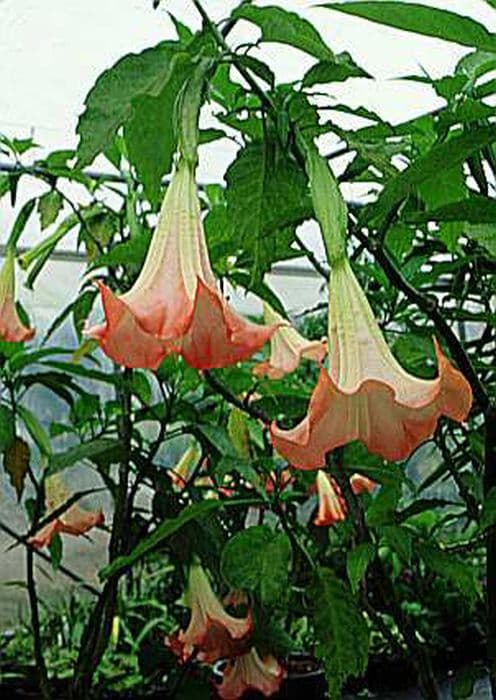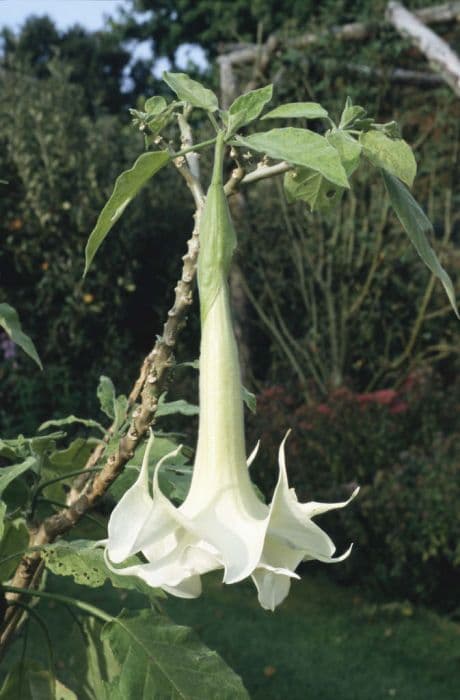Million Bells Calibrachoa Can-can Black Cherry (Can-can Series)
![calibrachoa [Can-can Black Cherry]](/_next/image?url=https%3A%2F%2Fplants-admin.emdemapps.com%2Fimages%2Fplants%2F%2Fimages%2F604b5421bc473.png&w=3840&q=75)
ABOUT
Calibrachoa Can-can Black Cherry, a variety within the Can-can series, showcases a stunning visual display with its unique coloration. The plant bears an abundance of small, petunia-like flowers. These blossoms boast a rich, deep red to blackish cherry hue that captivates and adds depth to garden compositions. The flowers' throats typically exhibit a slightly lighter shade, creating a beautiful contrast that draws further attention to the striking color. Each bloom is delicate and funnel-shaped, providing a continuous show of color throughout the blooming season. The plant itself has a trailing growth habit, with cascading stems that are lush with abundant green foliage which creates a beautiful backdrop for the vibrant blooms. The leaves are small and somewhat oval, with fine, subtle veining that complements the dense floral arrangement. Calibrachoa Can-can Black Cherry's distinctive color and generous flowering make it a popular choice for hanging baskets, containers, and as a spiller in mixed combinations, where it contributes drama and intensity to the planting scheme.
About this plant
 Names
NamesFamily
Solanaceae
Synonyms
Million Bells, Mini Petunia
Common names
Calibrachoa Can-can Black Cherry.
 Toxicity
ToxicityTo humans
Calibrachoa, commonly known as "million bells," is not considered highly toxic to humans. However, it may cause mild irritation or an allergic reaction if ingested or handled. There may be individual sensitivities resulting in symptoms such as stomach upset or skin irritation. These effects are normally not severe, but if any part of the plant is ingested and symptoms occur, it would be advisable to consult a medical professional.
To pets
Calibrachoa, also known as "million bells," is not listed as a highly toxic plant to pets such as dogs and cats. While the risk of severe poisoning is low, ingesting the plant might cause mild gastrointestinal upset in some pets, manifesting as symptoms such as vomiting or diarrhea. If a pet ingests this plant and shows signs of distress, contacting a veterinarian is recommended. However, pet owners should still prevent their pets from eating plants as individual animals may have different sensitivities.
 Characteristics
CharacteristicsLife cycle
Annuals
Foliage type
Evergreen
Color of leaves
Green
Flower color
Red
Height
1 foot (30 cm)
Spread
2 feet (60 cm)
Plant type
Herb
Hardiness zones
9
Native area
South America
Benefits
 General Benefits
General Benefits- Easy to grow - Calibrachoa, commonly known as Million Bells, is straightforward to care for, making it a good choice for novice gardeners.
- Long blooming period - Million Bells flowers prolifically from spring through fall, providing a long season of color.
- Attracts pollinators - The plant's vibrant flowers attract butterflies and hummingbirds, beneficial for pollination.
- Versatile in landscaping - Million Bells can be used in hanging baskets, containers, or as a ground cover, making it a flexible option for various garden settings.
- Drought-tolerant - Once established, Million Bells can tolerate periods of dryness, which is advantageous in water-conscious gardening practices.
- Minimal maintenance - It requires little pruning or deadheading, simplifying garden upkeep.
 Medical Properties
Medical PropertiesThis plant is not used for medical purposes.
 Air-purifying Qualities
Air-purifying QualitiesThis plant is not specifically known for air purifying qualities.
 Other Uses
Other Uses- Photography Prop: Calibrachoa is often used in garden photography due to its intense colors and beautiful blooms, adding contrast and interest to plant photoshoots.
- Edible Flower Garnish: Though not commonly consumed, the flowers of Calibrachoa can be used as a colorful garnish on salads and desserts, provided they are free of pesticides.
- Themed Decor: The deep, rich color of Calibrachoa Can-can Black Cherry is perfect for use in creating color-themed decor for events like Halloween or gothic-themed parties.
- Fairy Gardens: Its diminutive size and cascading habit make Calibrachoa great for use in whimsical fairy gardens, enhancing the miniature landscape.
- Artistic Inspiration: The vibrant flowers can serve as a muse for artists and crafters, inspiring paintings, textile patterns, and color schemes.
- Teaching Tool: Calibrachoa can be used in educational settings to teach children about plant growth, pollination, and the lifecycle of flowering plants.
- Eco-friendly Confetti: Dried petals of Calibrachoa can be used as a natural, biodegradable confetti for outdoor celebrations, reducing environmental impact.
- Table Centerpieces: Live or cut Calibrachoa flowers can serve as eye-catching table centerpieces for weddings, banquets, or other festive occasions.
- Scrapbooking: Pressed Calibrachoa flowers can be incorporated into scrapbooking projects or homemade greeting cards for a touch of nature.
- Nature Crafts: Incorporating Calibrachoa blooms into nature crafts, such as floral mobiles or wreaths, can add a splash of color and natural flair to home decor.
Interesting Facts
 Feng Shui
Feng ShuiCalibrachoa is not used in Feng Shui practice.
 Zodiac Sign Compitability
Zodiac Sign CompitabilityCalibrachoa is not used in astrology practice.
 Plant Symbolism
Plant Symbolism- Grace: The Calibrachoa's delicate blossoms are often associated with grace and elegance, reminding observers of the beauty found in nature.
- Endurance: Given the plant's ability to bloom prolifically from spring until frost, it symbolizes the capacity for endurance and perseverance through different circumstances.
- Joy: With its bright and vibrant colors, the Calibrachoa is thought to represent joy and happiness, bringing a cheerful presence to any environment.
 Water
WaterMillion Bells require regular watering to keep the soil consistently moist but not soggy. During the growing season, water them thoroughly whenever the top inch of soil feels dry to the touch, which might be about once or twice a week, depending on the climate and weather conditions. When watering, aim for about one to two gallons per plant per week, adjusting based on rainfall and temperature, to ensure deep hydration without waterlogging. In hot weather, they may need more frequent watering. Always ensure adequate drainage to prevent root rot.
 Light
LightMillion Bells thrive best in full sun, with at least six hours of direct sunlight daily. The ideal spot for these plants is in a location where they can receive ample morning sunlight and some protection from the intense heat of the late afternoon sun. They are versatile enough to also perform well in partial shade, but flowering may be reduced in less than full sun conditions.
 Temperature
TemperatureMillion Bells prefer a temperate climate and perform well when night temperatures are between 50 and 65 degrees Fahrenheit and day temperatures range from 70 to 85 degrees Fahrenheit. They can tolerate a minimum temperature of 35 degrees Fahrenheit and a maximum of about 90 degrees Fahrenheit. However, they will thrive when kept within this ideal temperature range and may struggle if the temperatures consistently fall outside of it.
 Pruning
PruningPruning Million Bells is important to maintain a bushy and well-shaped plant. Lightly trim the plant throughout the growing season to encourage branching and remove any spent flowers or leggy stems. Full pruning should be done in late winter or early spring, before new growth begins. This helps to rejuvenate the plant for the upcoming season and promotes more abundant blooms.
 Cleaning
CleaningAs needed
 Soil
SoilMillion Bells thrive in well-draining soil with a pH between 5.5 and 6.5. A mix of peat, perlite, and potting compost is ideal to ensure good aeration and moisture retention.
 Repotting
RepottingMillion Bells should be repotted every year in spring to refresh the soil and promote healthy growth. They may also need repotting if they outgrow their current container.
 Humidity & Misting
Humidity & MistingMillion Bells prefer moderate humidity levels but are quite adaptable. They do well in typical outdoor humidity conditions without special requirements.
 Suitable locations
Suitable locationsIndoor
Place Million Bells in bright indirect light and ensure well-drained soil.
Outdoor
Plant in full sun to partial shade with good draining soil mix.
Hardiness zone
9-11 USDA
 Life cycle
Life cycleCalibrachoa 'Can-can Black Cherry', commonly known as Million Bells, begins its life as a seed, which upon germination grows into a small seedling. The seedling stage involves the establishment of roots and a rosette of leaves at the soil level. As the plant matures, it enters a vegetative stage, characterized by rapid growth and the development of stems and additional leaves, preparing the plant for flowering. The flowering stage comes next, with the plant producing distinctive dark cherry-colored blooms that attract pollinators and are ideal for baskets and containers. After pollination, the plant may produce small, non-viable seeds, but the primary means of propagation is through cuttings rather than seed production. At the end of its growing season, especially in climates with cold winters, Million Bells is typically treated as an annual and will die, requiring replanting the following season, although in milder climates it may survive as a perennial.
 Propogation
PropogationPropogation time
Spring-Summer
The most popular method of propagating the Calibrachoa, also known as Million Bells, typically involves cuttings. This process is best done in late spring to early summer when the plant is actively growing. To propagate by cuttings, one should select healthy, non-flowering stems and cut a segment that is about 3 to 4 inches long (7.6 to 10.2 cm). Remove the leaves from the lower half of the cutting and dip the cut end into a rooting hormone. Then, the cutting should be inserted into a pot filled with a damp, soilless potting mix. It's crucial to maintain the humidity around the cutting by covering it with a plastic bag or dome and keeping it in indirect light until roots develop which usually takes a few weeks. After rooting has occurred, the new plants can be transplanted into individual pots or outdoor locations.


![Calibrachoa [Aloha Classic Blue Sky]](/_next/image?url=https%3A%2F%2Fplants-admin.emdemapps.com%2Fimages%2Fplants%2F%2Fimages%2F604b636c3778b.png&w=640&q=75)
![Calibrachoa [Aloha Classic Gold]](/_next/image?url=https%3A%2F%2Fplants-admin.emdemapps.com%2Fimages%2Fplants%2F%2Fimages%2F604b6284c573e.png&w=640&q=75)
![Calibrachoa [Aloha Classic Tiki Soft Pink]](/_next/image?url=https%3A%2F%2Fplants-admin.emdemapps.com%2Fimages%2Fplants%2F%2Fimages%2F604b548e0a5ef.png&w=640&q=75)
![Calibrachoa [Cabaret Deep Yellow]](/_next/image?url=https%3A%2F%2Fplants-admin.emdemapps.com%2Fimages%2Fplants%2F%2Fimages%2F604b5f20ca3ef.png&w=640&q=75)
![Calibrachoa [Calibasket Radiant Orange]](/_next/image?url=https%3A%2F%2Fplants-admin.emdemapps.com%2Fimages%2Fplants%2F%2Fimages%2F604b536d43cb2.png&w=640&q=75)
![Calibrachoa [Caloha Classic Blue Velvet]](/_next/image?url=https%3A%2F%2Fplants-admin.emdemapps.com%2Fimages%2Fplants%2F%2Fimages%2F604b604884a75.png&w=640&q=75)
![Calibrachoa [Caloha Classic Honey White]](/_next/image?url=https%3A%2F%2Fplants-admin.emdemapps.com%2Fimages%2Fplants%2F%2Fimages%2F604b5f56e0beb.png&w=640&q=75)
![Calibrachoa [Caloha Classic Yellow Chocolate Ring]](/_next/image?url=https%3A%2F%2Fplants-admin.emdemapps.com%2Fimages%2Fplants%2F%2Fimages%2F604b538aede95.png&w=640&q=75)